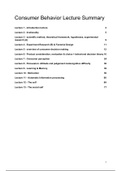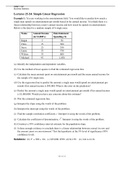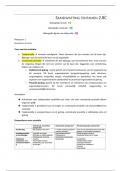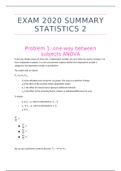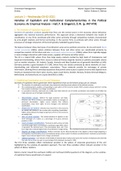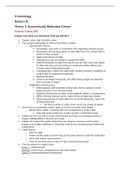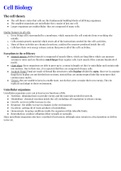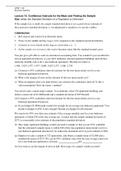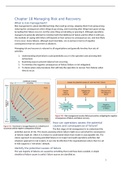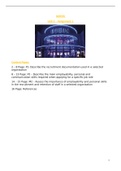Consumer Behavior Lecture Summary
Lecture 1 - Introduction lecture 2
Lecture 2 - Irrationality 5
Lecture 3 - scientific method, theoretical framework, hypotheses, experimental
research (A) 9
Lecture 4 - Experiment Research (B) & Factorial Design 11
Lecture 5 - overview of consumer decision making 12
Lecture 6 - Product consideration, evaluation & choice + behavioral decision theory 16
Lecture 7 - Consumer perception 24
Lecture 8 - Persuasion: Attitude and judgement metacognitive difficulty 30
Lecture 9 - Learning & Memory 39
Lecture 10 - Motivation 50
Lecture 11 - Automatic Information processing 60
Lecture 12 - The self 69
Lecture 13 - The social self 77
1
,Lecture 1 - Introduction lecture
Introduction to the study of consumer behaviour
Understand consumers
● what do they need?
● how do they decide?
● what makes them happy?
predict their reaction to marketing strategies
● changes to your product or service
● price changes
● change positioning
yeah, but
● not everyone is like you (false consensus).
● You often don’t even know
○ what you would do (affective forecasting)
○ why you do what you do.
Intuition trap: problems with common sense
intuition trap → We tend to project our own thoughts and attitudes on other consumers,
even though they are not representative. limited theories
- make decisions based on few observations
- infer causality from correlation
Intuitive trap
- Intuitive ideas are: easy, more vivid, appealing, well-remembered
- scientific stories are: complex, careful, situational
- ‘educated intuition’ → your intuition changes, for example better interpretation skills
Consumer Behavior definition
Processes involved selecting, buying, using or disposing of products, services, ideas and
experiences to satisfy needs and wants
(Solomon)
Thus:
1. obtaining products & services
2. consuming products & services
3. disposing of products & services
2
,Why study consumer behavior?
To know how to influence consumers
● firm → consumers
To know what consumers want
● consumers → firm
In other words, find out what consumers care about and provide.that.
Consumers are affected by both external and internal factors, which in turn influence our
behavior, cognition and affect.
● Consumers show/perform consumer behavior. This behavior is influenced by
marketing strategies and public policies.
3
,Regulate behavior: Public policy
● How will consumers react to regulations ?
○ e.g. cigarette warning labels
● How will consumers react to market changes?
○ recession, tax cuts, changes in mortgage subsidies
● change behavior: social marketing
○ Encourage/Discourage activities
○ Effect of advertising on society
● assumption: If people only know how bad something is, they will not do it.
Recap: Intuition trap - problems with common sense
● Often wrong (we are even bad at predicting our own choices)
● Confirmation Bias
○ we are resistant to changing our prior beliefs
○ we focus on confirming instances
● Your preferences are not representative
○ projection bias/ False consensus
● Intuitive ideas are: easy, more vivid, appealing, well-remembered
● scientific stories are: complex, careful, situational
Recap: Intuition trap - problems with common sense
● limited theories
● make decisions based on few observations
● infer causality from correlation
● overconfidence
Recap
what
● obtaining, consuming, and disposing products and services
● influenced by personal and external factors. Effect on affect, cognition, and behavior
why?
● marketers: understanding and predicting Behavior of consumer (to influence)
● Public policy: to regulate and encourage behavior
However, it is not easy → because consumers often act irrational
Key takeaways for the exam
● know why we study consumer behavior
● know the definition of the intuition trap and what problems it causes.
4
,Lecture 2 - Irrationality
The “wise” consumer assumption
The assumption is that...
● Preferences are clear and accessible in consumers minds
● consumers make trade offs between quality and price
● each product is judged on its merits alone
● willingness to pay is the result of evaluating the object we are interested in
● market research instruments accurately tell us what consumers really prefer and how
much they would pay
This assumption is basically what we should do, but this is often challenged
preference reversal → depending on how you position it, the preferences changes.
● In the Vendor L one, there is more ice cream than the cup can hold, which means
that you get more in that cup (at least, that is the perception)
● In the joint evaluation, cup sizes were compared by consumers instead of its
contents.
However, Value is not consistent, it seems arbitrary …
5
,Participants were asked to write the last two digits of their SSN, then bid for a variety of
items (wine, chocolates, etc.) SSN* Social Security Number
Researcher observed that people who had a lower SSN number had a lower willingness to
pay, because the SSN number was perceived as a point of reference and the WTP was
determined with the SSN number in mind.
… and depends on the set of alternatives
Compromise effect → ‘The share of a product increases when it is the intermediate option
but decreases when it is an extreme option’
A consumer is more likely to choose the middle option of a selection rather than the extreme
options, if the choice is perceived to be difficult. Consequently, the middle option is
perceived as the safe option, and solves this difficulty in preference fluency.
● middle option = safe option, resolves difficulty.
… and changes with ownership
● Sellers: ‘imagine that this cup is yours, How much would somebody have to pay to
buy it from you?’ (red line)
6
, ● Buyers: ‘Imagine you want to buy this cup. How much would you be willing to pay for
it? (green line)
● Endowment effect → ‘Owners assign greater value to a product than non-owners’
Reality about consumers
preferences are typically constructed on the spot, not revealed.
● Every evaluation is relative
○ ‘reference dependence
● People don’t know what they want until they see it in the context
○ ‘context dependence’
● Preferences change depending on how the alternatives are presented to them
○ ‘description dependence’
‘Rational’ consumers?
Rationality in economics
● people take into account the pleasure they obtain from consuming something
● the price they pay for it
● consumers want ‘value for money’
Setting prices
When it is free, people don’t think much about it. Many times it
shows that people are not always rational.
Choice overload
choice overload → Although the provision of extensive
choices sometimes still be seen as initially desirable, it may also prove unexpectedly
demotivating in the end.
Having a wide range of choices is nice, but as a consumer you can get lost into it.
● Jam Example (see next)
The Jam
More people stopped at the booth with 24 Jams! However, more people bought a Jam at the
booth with only 6 Jams. With tasting more, you have more difficulties such as
● ‘do I really have the best choice’ or ‘can I get better’,
making a decision becomes harder, because regret gets involved
● ‘Maybe I should have bought the other one’ (opportunity costs), therefore people end
up buying less. With the 6 Jams, more people bought it, as there was a clear
overview of choices.
7
Lecture 1 - Introduction lecture 2
Lecture 2 - Irrationality 5
Lecture 3 - scientific method, theoretical framework, hypotheses, experimental
research (A) 9
Lecture 4 - Experiment Research (B) & Factorial Design 11
Lecture 5 - overview of consumer decision making 12
Lecture 6 - Product consideration, evaluation & choice + behavioral decision theory 16
Lecture 7 - Consumer perception 24
Lecture 8 - Persuasion: Attitude and judgement metacognitive difficulty 30
Lecture 9 - Learning & Memory 39
Lecture 10 - Motivation 50
Lecture 11 - Automatic Information processing 60
Lecture 12 - The self 69
Lecture 13 - The social self 77
1
,Lecture 1 - Introduction lecture
Introduction to the study of consumer behaviour
Understand consumers
● what do they need?
● how do they decide?
● what makes them happy?
predict their reaction to marketing strategies
● changes to your product or service
● price changes
● change positioning
yeah, but
● not everyone is like you (false consensus).
● You often don’t even know
○ what you would do (affective forecasting)
○ why you do what you do.
Intuition trap: problems with common sense
intuition trap → We tend to project our own thoughts and attitudes on other consumers,
even though they are not representative. limited theories
- make decisions based on few observations
- infer causality from correlation
Intuitive trap
- Intuitive ideas are: easy, more vivid, appealing, well-remembered
- scientific stories are: complex, careful, situational
- ‘educated intuition’ → your intuition changes, for example better interpretation skills
Consumer Behavior definition
Processes involved selecting, buying, using or disposing of products, services, ideas and
experiences to satisfy needs and wants
(Solomon)
Thus:
1. obtaining products & services
2. consuming products & services
3. disposing of products & services
2
,Why study consumer behavior?
To know how to influence consumers
● firm → consumers
To know what consumers want
● consumers → firm
In other words, find out what consumers care about and provide.that.
Consumers are affected by both external and internal factors, which in turn influence our
behavior, cognition and affect.
● Consumers show/perform consumer behavior. This behavior is influenced by
marketing strategies and public policies.
3
,Regulate behavior: Public policy
● How will consumers react to regulations ?
○ e.g. cigarette warning labels
● How will consumers react to market changes?
○ recession, tax cuts, changes in mortgage subsidies
● change behavior: social marketing
○ Encourage/Discourage activities
○ Effect of advertising on society
● assumption: If people only know how bad something is, they will not do it.
Recap: Intuition trap - problems with common sense
● Often wrong (we are even bad at predicting our own choices)
● Confirmation Bias
○ we are resistant to changing our prior beliefs
○ we focus on confirming instances
● Your preferences are not representative
○ projection bias/ False consensus
● Intuitive ideas are: easy, more vivid, appealing, well-remembered
● scientific stories are: complex, careful, situational
Recap: Intuition trap - problems with common sense
● limited theories
● make decisions based on few observations
● infer causality from correlation
● overconfidence
Recap
what
● obtaining, consuming, and disposing products and services
● influenced by personal and external factors. Effect on affect, cognition, and behavior
why?
● marketers: understanding and predicting Behavior of consumer (to influence)
● Public policy: to regulate and encourage behavior
However, it is not easy → because consumers often act irrational
Key takeaways for the exam
● know why we study consumer behavior
● know the definition of the intuition trap and what problems it causes.
4
,Lecture 2 - Irrationality
The “wise” consumer assumption
The assumption is that...
● Preferences are clear and accessible in consumers minds
● consumers make trade offs between quality and price
● each product is judged on its merits alone
● willingness to pay is the result of evaluating the object we are interested in
● market research instruments accurately tell us what consumers really prefer and how
much they would pay
This assumption is basically what we should do, but this is often challenged
preference reversal → depending on how you position it, the preferences changes.
● In the Vendor L one, there is more ice cream than the cup can hold, which means
that you get more in that cup (at least, that is the perception)
● In the joint evaluation, cup sizes were compared by consumers instead of its
contents.
However, Value is not consistent, it seems arbitrary …
5
,Participants were asked to write the last two digits of their SSN, then bid for a variety of
items (wine, chocolates, etc.) SSN* Social Security Number
Researcher observed that people who had a lower SSN number had a lower willingness to
pay, because the SSN number was perceived as a point of reference and the WTP was
determined with the SSN number in mind.
… and depends on the set of alternatives
Compromise effect → ‘The share of a product increases when it is the intermediate option
but decreases when it is an extreme option’
A consumer is more likely to choose the middle option of a selection rather than the extreme
options, if the choice is perceived to be difficult. Consequently, the middle option is
perceived as the safe option, and solves this difficulty in preference fluency.
● middle option = safe option, resolves difficulty.
… and changes with ownership
● Sellers: ‘imagine that this cup is yours, How much would somebody have to pay to
buy it from you?’ (red line)
6
, ● Buyers: ‘Imagine you want to buy this cup. How much would you be willing to pay for
it? (green line)
● Endowment effect → ‘Owners assign greater value to a product than non-owners’
Reality about consumers
preferences are typically constructed on the spot, not revealed.
● Every evaluation is relative
○ ‘reference dependence
● People don’t know what they want until they see it in the context
○ ‘context dependence’
● Preferences change depending on how the alternatives are presented to them
○ ‘description dependence’
‘Rational’ consumers?
Rationality in economics
● people take into account the pleasure they obtain from consuming something
● the price they pay for it
● consumers want ‘value for money’
Setting prices
When it is free, people don’t think much about it. Many times it
shows that people are not always rational.
Choice overload
choice overload → Although the provision of extensive
choices sometimes still be seen as initially desirable, it may also prove unexpectedly
demotivating in the end.
Having a wide range of choices is nice, but as a consumer you can get lost into it.
● Jam Example (see next)
The Jam
More people stopped at the booth with 24 Jams! However, more people bought a Jam at the
booth with only 6 Jams. With tasting more, you have more difficulties such as
● ‘do I really have the best choice’ or ‘can I get better’,
making a decision becomes harder, because regret gets involved
● ‘Maybe I should have bought the other one’ (opportunity costs), therefore people end
up buying less. With the 6 Jams, more people bought it, as there was a clear
overview of choices.
7

